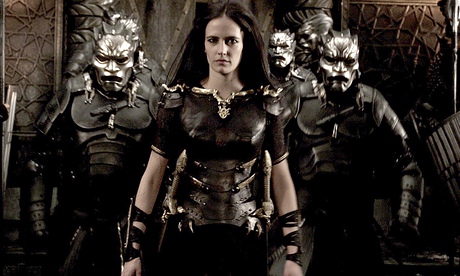
The battle of Salamis in 480BC was the major turning point in the Greco-Persian wars. Themes
The first few minutes of 300: Rise of an Empire set out its wares: there's beheading, jiggling breasts, rape, a world view derived from Fox News (Darius the Great of Persia invaded Greece, we learn, because he was 'annoyed by Greek freedom'), macho military anachronism (Greek hero Themistocles is skilled in something called 'Athenian shock combat'), blood and mud both spurting around in 3D on the screen like thick black slime, waxed chests, teeny tiny leather man-panties, a portentous voiceover and racism. If you love all that stuff, saddle up your battle rhino: the wilful massacre of ancient Mediterranean history that was 300 is back. People
At the battle of Marathon in 490BC, Themistocles (Sullivan Stapleton) hacks his way through a beachful of Persians. He spies Darius the Great watching the battle from a ship, and shoots him with an arrow. 'Themistocles knew in his heart he had made a mistake,' intones the voiceover. You bet he did. The real Darius wasn't at the Battle of Marathon, and Themistocles didn't kill him. The Achaemenid King of Kings lived for another four years and died naturally following an illness. But no, the film isn't owning up to having blooped: it is suggesting that by killing Darius, Themistocles has opened the way for Xerxes (Rodrigo Santoro) to take over. You know, the massive gilded embodiment of orientalism from last time round.
Reading on mobile? Watch the trailer here Military
Cut to the Achaemenid empire, and to a palace which is probably supposed to be Persepolis, but looks more like the headquarters of the Tyrell Corporation in Blade Runner. Darius is dying so slowly from his arrow wound that he has managed to travel 4,000 kilometres with it still sticking out of his chest. Xerxes is distraught; so is Artemisia (Eva Green), the Achaemenids' most ruthless military commander and most total babe. In real life, Artemisia was queen of Halicarnassus. She was indeed a famous and heroic fighter, prompted to join the campaign, according to Greek historian Herodotus, 'by the formidably masculine cast of her bravery'. She was not what 300: Rise of an Empire turns her into: a peasant girl brutalised by years of rape (this film misses no opportunity to show or imply rape) who has malevolently blossomed into Bondage Nymphomaniac Revenge Barbie. Slavery
Most of the film is taken up with sea-battles, especially the battle of Salamis. These battles are - it must be said - spectacularly staged. Historians may be irritated to see ships rowed by galley slaves, a legend popularised by the book and movie Ben-Hur but rarely seen in the classical world. Rowing was a skilled profession and therefore not considered suitable for slaves. Aristotle states specifically in his Politics that the fact ordinary citizens rowed the ships at Salamis strengthened Athenian democracy. War
Themistocles and Artemisia indulge in a brief, ahistorical bout of hate sex, which fails to avert the war but does mean viewers get to see more breasts. The film is vaguely right in showing the Greeks drawing the much larger Persian fleet into the narrow Straits of Salamis, so as to negate the advantage of their greater numbers. Historian and translator of Herodotus's Histories Tom Holland, whose own book Persian Fire is a gripping account of the Greco-Persian wars, admired the first 300 film for its authentically Spartan perspective. Yet this one, he has said, ' is to the Herodotean narrative of the Persian Wars rather what Hogwarts is to the average British school', adding: 'In one way, the battle of Salamis is very true to the Herodotean narrative: it's almost impossible to work out what's going on.' Distractingly, almost every scene has been overlaid by VFX of sparks, cinders and bits of dust floating around in the air, so that the whole affair begins to resemble a gay neoconservative snowglobe.
Analogies
The Persians unleash a huge metal bomb-ship that chugs out pitch and a detachment of frogmen suicide bombers. Are there huge metal bomb-ships and suicide bombers in Herodotus? No. But without them you may not have realised just how racist and silly this film is prepared to be. Meanwhile, the Spartans turn up at the last minute to save the day (they didn't) led by Queen Gorgo (they weren't) with hundreds of ships (they had 16). Themistocles slays Artemisia with heavy-handed symbolism by thrusting his great big sword lustily into her tummy. The real Artemisia escaped at the Battle of Salamis, provoking Xerxes to declare: 'My men have become women, and my women men.' She was trusted by Xerxes as an adviser after the battle, and was charged with the care of some of his bastard children. Her ultimate fate is not known. Themistocles's is, though this film doesn't mention it: he joined the Persians. Verdict
Please don't make a third film.
* Read Peter Bradshaw's review of the film
Post By http://www.theguardian.com/film/filmblog/2014/mar/12/300-rise-of-empire-reel-history-persians-greeks-salamis





0 comments Blogger 0 Facebook
Post a Comment
Click to see the code!
To insert emoticon you must added at least one space before the code.